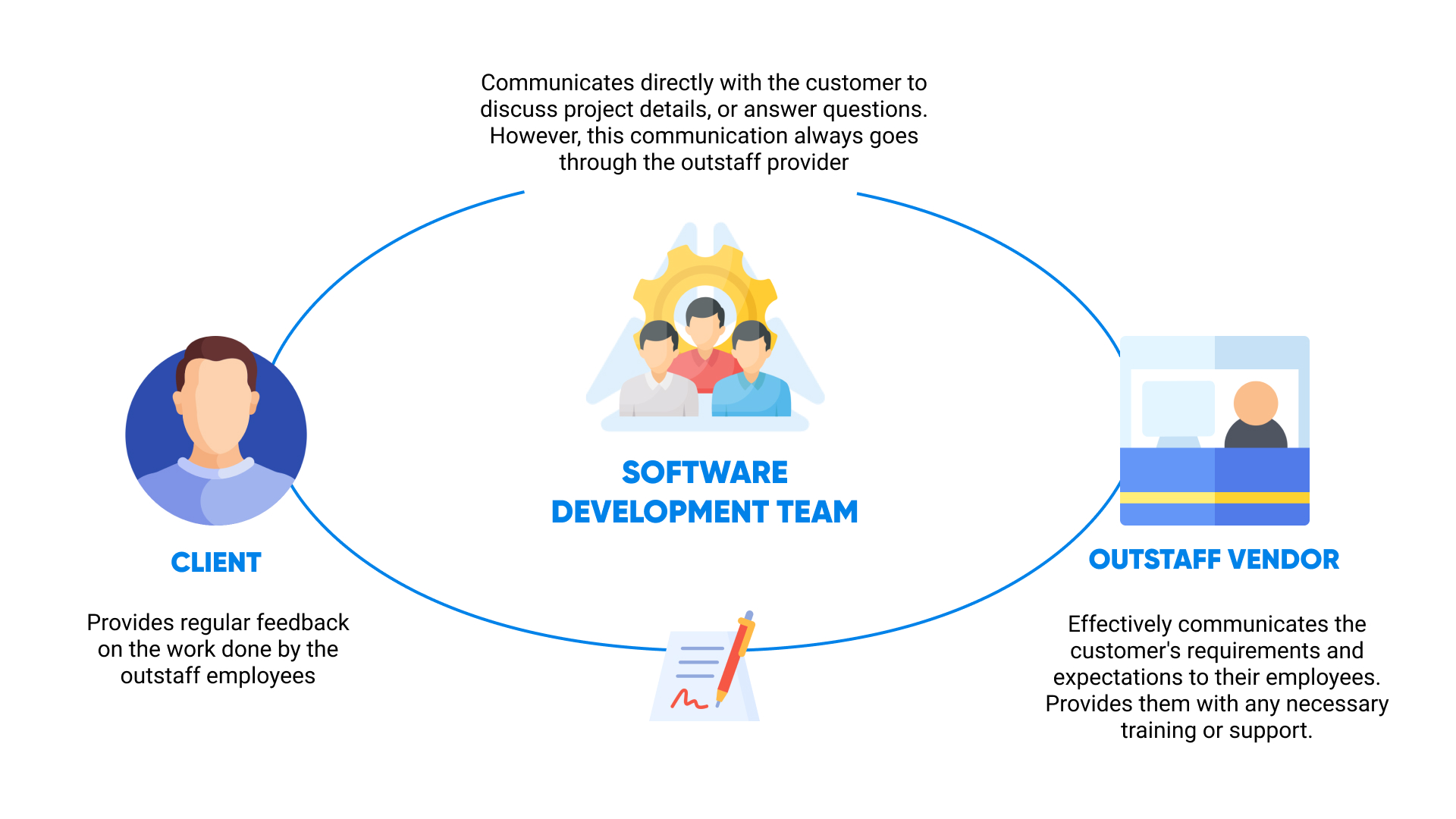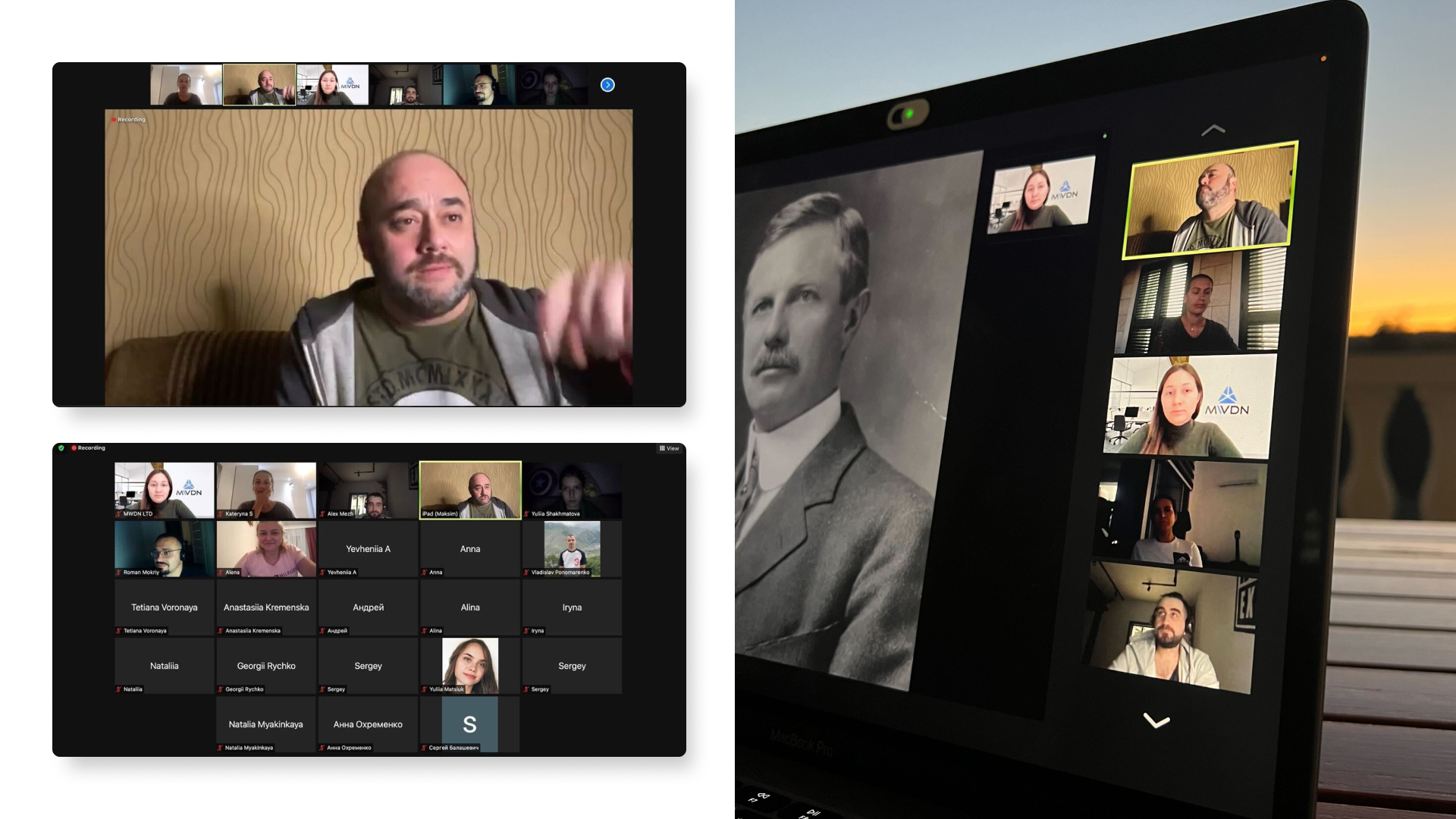
Outstaff software development teams are becoming increasingly popular in today’s globalized world, offering businesses the opportunity to access top talent from around the world while keeping costs low. However, with team members spread across different time zones, languages, and cultures, communication can be a significant challenge.
Content:
- What is outstaffing? Specifics of communication in outstaff teams
- Communication in Triangle “Customer-Outstaff Provider-Employee”
- Why is well-established communication important?
- Strategies for transparent communication in outstaffing development teams at MWDN
- Do you require a software development team?
Effective communication is crucial for successful software development, as miscommunication can lead to costly mistakes, delays, and decreased productivity. In this article, we will explore the various communication challenges faced by outstaff software development teams and provide practical tips and strategies for navigating these challenges from first-hand experience of a global outstaff service provider.
What is Outstaffing? Specifics of Communication in Outstaff Teams
If you’re running a small business, you may need to hire a team of developers to build a new website or software application any minute. You could hire these specialists as full-time employees, but that can be expensive and time-consuming. Plus, you might not have enough tasks to keep them busy full-time. That’s where outstaffing comes in. Instead of hiring full-time employees, you can work with an outstaff provider to find and hire remote workers who will work exclusively for your business on a project basis. This means you only pay for the work you need, and you don’t have to worry about the administrative tasks that come with traditional employment, such as payroll and benefits.
But why is outstaffing better than traditional outsourcing? Well, traditional outsourcing typically involves hiring a third-party company to complete a specific project or task. This can be effective for one-off projects, but in this case, building a long-term relationship with the outsourced company might be a challenge. Plus, you might not have as much control over the project as you would like to.
With outstaffing, on the other hand, you have a dedicated team of specialists who work exclusively for your company. You have more control over the project, and you can build a long-term relationship with the outstaff provider and their employees. Plus, because these experts work exclusively for your project, they become more familiar with your business needs and can deliver higher-quality development solutions.
| Traditional outsourcing | Outstaffing |
|---|---|
| As a rule, your remote employees work at least on several projects. | Remote employees work exclusively for your company on a project basis. |
| You pay a fixed price for the entire project or time spent on the project and the cost of the materials used. | You only pay for the work you need. |
| You don't have to worry about the administrative tasks. | You don't have to worry about the administrative tasks. |
| You’re not involved in project management. | You directly manage the team. |
Outstaffing has its own nature and communication within this model has its own intricacies that may seem complex at first. Let’s discuss this further.
Communication in the triangle “customer – staff provider – employee”
Communication in outstaff teams might be challenging due to the triangular relationship between the customer, the staff provider, and the employee. Some common difficulties that can arise in communication within an outstaff team include language barriers, cultural differences, time zone differences, and lack of face-to-face interaction. Let’s have a closer look at the relationship between a customer, a staff provider, and an employee and define their responsibilities on the project.

Communication between a customer and a staff provider
A customer needs to clearly communicate their requirements and expectations to the staff vendor, as well as provide regular feedback on the work done by the outstaff employees. The staff vendor, in turn, needs to ensure that their employees understand the customer’s requirements and can deliver high-quality work.
Communication between a staff provider and an employee
A staff provider needs to effectively communicate the customer’s requirements and expectations to their employees, as well as provide them with any necessary training or support. Employees also need to communicate any challenges or issues they encounter to the outstaff provider in a timely manner.
Communication between a customer and an employee
A customer may need to communicate directly with the outstaff employee to provide feedback, discuss project details, or answer questions. However, this communication should always go through the outstaff provider to ensure that all parties are on the same page and that there are no misunderstandings.
Why is well-established communication important?
Software development is a collaborative process that requires team members to work together to achieve common goals. Effective software development communication is critical for ensuring that everyone is on the same page and that the project is progressing as planned.
When team members communicate effectively, they can identify potential issues and address them before they become bigger problems. Good communication can also help to improve productivity by reducing misunderstandings and delays. When team members know what is expected of them and have clear goals and timelines, they can work more efficiently.
For all these reasons, building a culture of trust, transparency, and collaboration is essential for effective communication in software development teams. By using collaboration tools and regular feedback, outstaffed teams can improve project outcomes, increase productivity, and reduce risk.
Strategies for transparent communication in outstaffing development teams at MWDN
During decades on the market, we have completed more than 200 projects and have built more than 50 successfully extended teams. This experience allowed us to develop our own set of rules and strategies for the successful organization of teamwork at outstaff projects. In this chapter, we share them and break down how they help overcome challenges in teamwork.
#1 Clear remote team management
Remote team management plays a critical role in facilitating communication in outstaff teams. The use of agile methodologies can ensure that everyone is working towards the same goal, communication is clear, and the project stays on track. For example, the introduction of Scrum or Kanban can ensure frequent communication and collaboration between team members and ensure that everyone is working towards the same goal.
Over the years, MWDNers have followed a flexible and iterative approach to software development that prioritizes collaboration, continuous feedback, and adapting to changing requirements. In addition to these methodologies, we set up clear expectations and roles for team members to improve communication and ensure everyone is on the same page. This includes setting clear project goals, defining roles and responsibilities, and establishing communication protocols.
#2 Regular video conferences
Regular video conferences are an essential component of effective communication in outstaff teams. Daily stand-ups or daily meetings are another proven way that can keep team members informed of each other’s progress and identify any issues or roadblocks.
We foster regular face-to-face interaction with our development teams through video conferences in secure communication channels which help everyone involved in the project build trust and support between team members who, in most cases, have not met in person. Regular communication in our team implies:
- Daily stand-up meetings and instant messaging.
- Sprint planning meetings at the beginning of each sprint to plan and prioritize the work to be done.
- Sprint reviews.
- Retrospectives.
- Client meetings.
- One-on-one meetings.
- Ad-hoc meetings.
Regular communication is a proven way to resolve issues quickly by allowing team members to discuss problems in real time.
#3 Instant messaging and project management tools
Instant messaging means real-time communication through various project management tools that facilitates the process of work. Asana, Trello, Jira, and Basecamp can provide a centralized platform for team members to manage tasks, track progress, and communicate with each other. These tools allow team members to assign tasks, set deadlines, monitor progress, keep the project on track, and ensure that everyone is working towards the same goal. Also, project management tools often include communication features such as chat and comment sections, which facilitate real-time communication and collaboration.
Internally, we use People Force and Trello as centralized platforms for sharing information, assigning tasks, and tracking progress. We also maintain communication with employees through Slack, exchanging instant messages and keeping in touch regularly.
At projects, we tune up to the internal needs of the client and keep the record of tasks in the project management tools they typically use. The use of project management tools is discussed at the early stages of the project, so each of our projects begins with a clear understanding of how the communication process will take place.
#4 Clear and concise communication
Working as an international outstaff service provider has its own intricacies and a good share of challenges related to the language barrier. To minimize misunderstandings, use clear and concise language when communicating. For example, avoid idiomatic expressions, slang, or humor that may not translate well across cultures. A good way to avoid misunderstandings is to hire team members who are fluent in working languages and can bridge language barriers and facilitate communication between team members.
Providing language training to team members who are not fluent in the primary working language is also a good way to improve their proficiency and reduce misunderstandings. And, of course, remember that we live in the age of technology, and it can also be leveraged to help bridge language barriers. For example, modern translation tools can be used to translate written or spoken communication in real time.
#5 Cultural awareness

Image: MWDN teambuilding — Online lecture about Kharkiv
Cultural awareness training, respecting cultural differences, adapting communication styles, and building relationships are critical in establishing effective communication and setting up the right work tone in outstaff teams. Training, for example, can help team members understand the different cultural norms and communication styles of their colleagues. They show the importance of respecting cultural differences and avoiding making assumptions about other members based on one’s own cultural norms. The adaptation of communication style to suit the cultural norms of the team can also improve communication.
Based on our experience, building relationships with team members can also help overcome cultural barriers. This includes taking the time to get to know team members on a personal level, sharing information about one’s own culture, and being open to learning about others’ cultures.
Do you require a software development team?
Look no further than MWDN. With our international presence across Israel, Canada, the EU, the US, Ukraine, and Poland, we have the expertise in building and managing successful global teams. Despite our employees being scattered across the world, we set up proper communication channels to ensure seamless collaboration and transparency throughout the project. This approach helps us to pull out the best specialists from around the world, ensuring that our clients receive the highest quality solutions to meet their business needs.
Here’s how much your dedicated remote team can cost you with MWDN:
| Software Engineer | QA Engineer | DevOps | Security Specialists | ML Engineer | Research Engineer | Business Analyst | Media Buyer | UI/UX Designer |
|---|---|---|---|---|---|---|---|---|
| $3,600 | $2,850 | $4,500 | $3,350 | $3,900 | $5,000 | $3,250 | $2,350 | $2,850 |
These are the costs per month, with all administrative and organizational fees included. With over 200 active employees and a private database of the best tech applicants, we can cover every requirement of yours. Contact MWDN to build your global software development team and take your business to the next level.
